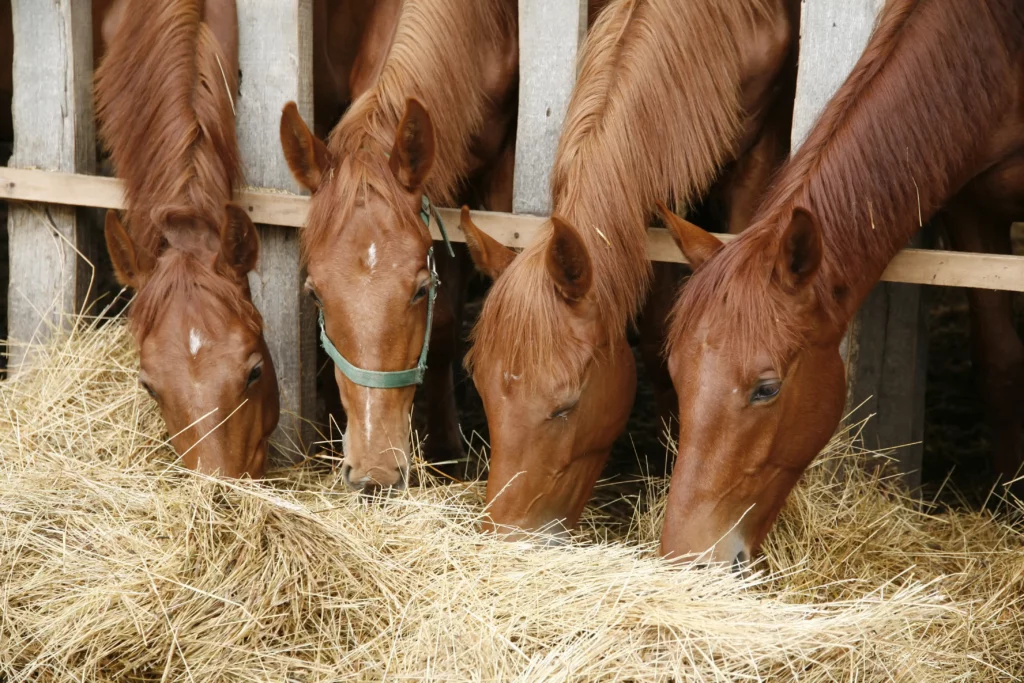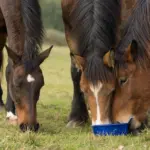More and more stable owners are going to great lengths to produce truly good, healthy, horse-friendly hay. A heartfelt thank-you to all these farmers — because hay is the foundation of equine health.
And yet, it keeps happening: top-quality, dry hay is harvested and stored under ideal conditions — but then, sometime between January and March, you open a bale and find it’s gone mouldy. How can that be? The hay was perfectly dry at harvest and showed no signs of mould at all.
Living plants can fend off mould
As long as the plants are vital and healthy, they defend themselves against infestation by microorganisms — including various bacteria, viruses, and fungi. Once a plant dies, it loses its natural defences, and mould spores — which are found everywhere — begin to settle on and break down the dead plant material. Unlike plants, fungi can’t produce their own energy from sunlight and carbon dioxide. Fungi occupy an intermediate position between plants and animals: unlike animals, they can’t move independently, but unlike plants, they don’t perform photosynthesis. Fungi are what we call saprophytes — they feed on dead organic matter. That’s why mould loves to grow on dead plants: for the fungus, it’s like an all-you-can-eat buffet.
Late-cut hay often already contains mould spores
The later hay is cut, the more dead plant material is already present in the field. For example, once a grass plant has flowered, produced seeds, and those seeds have ripened and fallen to the ground, its job for the year is done. It draws its energy and nutrients back down into the roots, ready to grow again the following spring. The dead parts above ground can then be colonised by mould. You can spot this in hay when the leaves of these already-dead grasses show grey spots or rings that can’t be wiped off with your finger — because the mould is growing inside the plant, not just on the surface. That means mould can already be present in the bale at the time of harvest, without being visibly noticeable.

© Adobe Stock/acceptfoto
Earlier mowing is not a solution
You might think the obvious solution is simply to cut the hay earlier, while the plants are still healthy. But when it comes to producing hay for horses, that leads to another issue: the nutrient content becomes too high. The earlier the cut, the richer the hay — especially in protein and sugar. Since many horses today are already carrying too much weight, the goal should be to produce hay with lower nutrient levels. This allows for ad-lib hay feeding — which is vital for the horse’s digestive health and mental well-being — without increasing the risk of obesity.
Early cutting doesn’t really prevent harvest mould either. Around 50 hours after mowing, mould fungi begin to colonise the cut grass — a completely normal process. Once the plant is cut, it dies, loses its natural defences, and mould begins to move in. Since hay typically takes three to five days to dry properly before it can be baled — depending on weather conditions — there is always a small amount of mould present in hay that’s dried on the ground. This isn’t necessarily a problem at first, as the levels are so low they don’t pose a health risk to horses — as long as the mould doesn’t continue to grow during storage.
When it comes to winter weather, there’s no easy fix
Crisp, cold winter temperatures usually come with low humidity — not ideal conditions for our mouldy little lodgers that settled into the bales at harvest. In this kind of environment, mould fungi can’t continue to spread, the contamination stays minimal, and the hay can be fed without any problems.
It’s a different story when we have a damp, mild winter — something that’s becoming increasingly common due to climate change. At around zero degrees Celsius with 98% humidity, mould finds perfect conditions to slowly continue growing inside the bale and gradually spread. That’s why you might open a new bale in January, February, or March and suddenly be faced with unexpected mould contamination.
How to handle poor-quality hay
The problem is that in these cases, you can’t simply throw the hay away and get more from the neighbour — because they’re usually facing the exact same issue. In such winters, you often have no choice but to keep feeding the hay and manage the horses as best as possible to help them cope with it.
This includes moistening the hay (e.g. with a watering can or spray bottle) to reduce dust and relieve the respiratory system, as constantly inhaling mould-spore-laden hay dust can lead to allergies over time. For horses that are already sensitive or allergic to mould spores, steaming the hay is often the only effective solution. DIY instructions for hay steamers can be found online, and there are also commercial suppliers of such equipment. To help protect the horse’s metabolism, mould toxins can be bound in the gut by feeding so-called mycotoxin binders, such as OKAPI EndoProtect. This prevents them from being absorbed through the intestinal wall.
No doubt — these are far from ideal conditions. And with climate change bringing increasingly unstable weather patterns in both winter and summer, it may be worth considering the investment in a hay dust extraction system or a hay drying unit in the medium term to ensure better hay quality. However, both options involve significant costs and are usually only practical for large-scale operations or agricultural cooperatives. For individual horse owners, they’re often financially out of reach. That means the best approach is to aim for the highest possible hay quality from the start — and, if necessary, take appropriate measures to manage the situation until the grazing season begins and fresh hay is available again.
There’s also an article on hay quality available here:
Heukonservierung und Heudesinfektion
- Vitamin A in Horses – Origin, Metabolism, Function, and Requirements - 15. May 2025
- Linseed in Horse Feeding - 28. January 2025
- What is Adiponectin And How Can We Use It? - 21. October 2024










